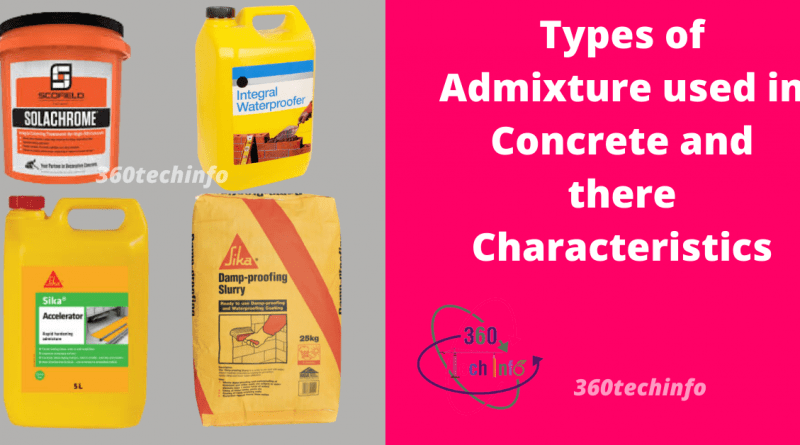Types of Admixture Used in Concrete and there Characteristics II Uses of Admixture
In this topic we are discussing about types of admixture used in concrete and there characteristics also various uses of admixture in concrete.
What is Admixture in Concrete?
Admixture is add on additives at the time of concrete mix that can assist in controlling the setting time and other characteristics of fresh concrete.
Adding extra chemical or natural ingredients to concrete before or during mixing is known as admixture, which may take the form of liquid, powder, or paste. The concrete admixtures can be natural, manufactured chemicals, or semi-synthetic chemicals. These chemicals may be retarders, accelators, plasticizers, fungicides, water-resistant agents, corrosion inhibitors, or any other type of chemical.
Why Admixture are Used in Concrete?
Fresh or hardened concrete is usually given special properties by adding an additive. An additive can improve the durability, workability, or strength characteristics of a concrete mixture.
During construction, it is often necessary to use a mixture to overcome difficult situations such as cold or hot weather placement, pumping requirements, or very low water to cement ratio specifications.
How Admixture used in Concrete
Generally Alum, Lime, Mineral Oil, Organic Oil, Potassium Chloride, Tar, Zinc Chloride, Volcanic Ash, and Carbon are used as common examples of admixtures in concrete.
Concrete admixture used to reduce water, accelerate concrete strength, add air, prevent alkali aggregate expansion, form gas, act as a waterproofing agent, and reduce joint pressure. It increases the early and ultimate strengths of concrete and also it enhances the self-travel ability and final setting time of concrete.
Here are some concrete additives used for a variety of purposes
Mineral Admixture in Concrete
As well as improving economics, reducing permeability, increasing strength and influencing other properties of concrete, mineral admixtures enhance the performance of mixtures.
A mineral admixture can modify the hardened concrete’s characteristics by acting hydraulically or pozzolanically. There are many types of pozzolans, including natural pozzolans (such as the volcanic ash in Roman concrete) and fly ash and silica fume. These can be used individually or in combinations with Portland or blended cement.
Types of concrete admixtures based on their functions
Depending on the function, concrete admixtures can be categorized as follows:
- Water Proofing Admixture
- Pozzolanic Admixture
- Retarding Admixtures
- Accelerator Admixture
- Hydration control Admixture
- Corrosion Inhibitors Admixture
- Shrinkage Reducing Admixture
- Insecticidal Admixture
- Bonding Admixture
- Anti-wash out Admixture
- Grouting Admixture
Now we describe Types of Admixture Used in Concrete and there Characteristics-
Water Proofing Admixture in Concrete-
Concrete is waterproofed with admixtures in the construction industry to prevent water from leaking through hardened concrete. Waterproofing admixtures also says as permeability resistive admixture, water resisting admixtures, or damp proofing admixtures.
The following are examples of water proofing additives-
- Aluminium Sulphate,
- Calcium chloride
- Silicate of soda
Pozzolanic admixture in concrete–
Several alkali materials found in water are used to reduce the hydration and thermal structure of RCC work in new generation technologies. It is also used for the production of water retaining structures such as dams and talabs.
Fly Ash and silica are example of pozzolona Admixture.

Retarding admixtures in concrete–
Admixtures that delay concrete’s setting time are commonly found in concrete. The high temperatures of fresh concrete (30°C [86°F]) often cause it to harden at a faster rate, making it difficult to finish. The most practical method of counteracting this effect is to lower the temperature of the concrete by cooling the water or the aggregates used in mixing. Concrete bleeding rates and bleeding capacities are increased by retarders, but they do not decrease the temperature of the concrete at the onset of bleeding.
Gypsum, Calcium sulphate, starch are example of retarding admixture.
Accelerator admixture in concrete–
The admixture is commonly used in cold climate zones where concrete needs to set up quickly as well as harden quickly. It will reduce the setting time of concrete and accelerate the setting and hardening process. Concrete usually takes time to set in cold season, that’s why accelerating types of admixtures are added to concrete to reduce its setting time.
A concrete accelerator admixture is used to accelerate the hydration (setting) and strength development process early in the concrete production process.
An example of a accelerator admixture is (1) calcium formate, (2) calcium chloride, and (3) silicon fume.
Hydration control Admixture in Concrete–
These are chemical systems consisting of two components: (1) a stabilizer or retarder which effectively stops material saturation, and (2) a catalyst which re-establishes normal hydration and setting when added to stabilized concrete. It is best to add the activator shortly before using the concrete, since the stabilizer suspends hydration for 72 hours. Adding these admixtures to concrete allows it to be reused after it is returned from a ready-mix truck. As a stabilizer, the admixture can maintain concrete in a no hardened state during transport.
Corrosion Inhibitors admixture in concrete–
Concrete used for parking structures, marine structures, and bridges that are exposed to chloride salts must be protected against corrosion. Corrosion-inhibiting additions chemically arrest the corrosion reaction by preventing chloride ions from attacking the steel and killing the passivating oxide layer. Commonly used corrosion inhibitors admixture are- Calcium Nitrate, Phosphate, Sodium Nitrate.
Shrinkage Reducing Admixture in Concrete-
Since the 1980s, shrinkage-reducing admixtures have been developed for bridge decks, floors, and buildings that require minimal cracking and curling for durability or aesthetics. Example of shrinkage reducing admixture are Propylene glycol and polyoxy alkaline alkyl ether.
Damp-proof Admixture-
There are some dampproofing additives that can be used in concrete that is in touch with water or damp earth in order to reduce moisture transmission. However, many of these products are ineffective when utilised on concrete that is under pressure due to water.
A dampproofing agent is a mixture of soaps, stearates, and petroleum products.

Insecticidal admixture in Concrete–
Whenever fresh concrete comes into contact with water, moisture, and air, there are a variety of germs and microorganisms that germinate on its surface. Using insecticidal admixtures is a good way to prevent bacteria and fungi from growing. The most common admixture used in insecticides is poly halogenated phenol.
Bonding Admixture in Concrete-
When we apply new concrete material on old concrete surfaces, bonding between old and new concrete is poor. This type of admixture is used when we make new concrete surfaces over old concrete surfaces.
Polymers, polyvinyl chloride, polyvinyl acetate, acrylics, styrene butadiene copolymers, and rubber are commonly used in bonding admixtures.
It is only the surface to which a bonding admixture is applied that will have the greatest effect on the final result. The surface should be dry, clean, sound, free of oil, grease, or dirt, and it should be at the correct temperature.

Anti-wash out Admixture in concrete-
A concrete antiwashout admixture increases cement’s cohesiveness to such a degree that it is less affected by water exposure. A mix containing these admixtures will be thixotropic and resistant to segregation because it will have an increased viscosity of water in it.
Cellulose are most commonly used antiwash out admixture.
Grouting Admixture for Concrete-
There are a number of uses for Portland cement grouts. For stabilizing foundations, setting machine bases, filling cracks and joints, and cementing oil wells. Grout can be modified with various types of admixtures that entrain air, accelerators, retarders, and do not shrink for specific applications.

At the Last- Do you think this post Types of Admixture Used in Concrete and there Characteristics is useful for you or the post is informatics. Then please comment and share the post with your friends your one share can give us motivation to create such post. If there are any new input or updates needs please comment below to improve it. Thank you for connecting with us.





